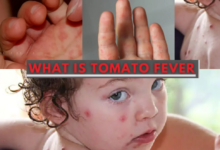What is Tomato Fever: Tomato Flu Symptoms And Causes

What is Tomato Fever? Kerala has indeed registered 82 cases of ‘Tomato Flu’ or ‘Tomato Fever,’ according to national media sources, with the number expected to rise. The specific etiology of the illness currently unexplained.
The formation of a new virus in Kerala occurs only days after a little girl died after contracting Shigella bacteria after eating a shawarma wrap from a restaurant in Kasaragod, Kerala.
What Is Tomato Fever?
Tomato fever is indeed an unknown virus that primarily affects the Indian state of Kerala. It’s also unclear whether the illnesses are caused by a viral fever or is a side benefit of chikungunya or dengue malware infections.
The Tomato Fever seems to have the biggest influence in the cities of Kollam, Neduvathur, Anchal, and Aryankavu, most of which are in Kerala. Anganwadi centers have already been closed as a precaution, and officials have started small-scale awareness measures to encourage awareness.
The Kerala Department Of health is keeping a close eye on the issue because the illness affects kids under the age of five, making it a public health emergency. All 82 cases of Tomato Fever that have already been documented have occurred in Kollam. What’s more alarming is that all of the confirmed instances have involved kids under the age of five, but they’ve all been reported to public health officials.
Tomato Fever Symptoms
Tomato illness is characterized by rashes the size of tomatoes, skin irritation, and symptoms of dehydration on the tongue of a child suffering from the disease.
The worms had indeed emerged from the boils, according to a small number of patients. Rashes, skin discomfort, and dehydration are common symptoms of an infected child.
As a consequence, blisters form in various parts of the body. The term “tomato flu” or “tomato fever” stems from the fact that these blisters are generally spherical in shape and red in color, earning them the moniker.
Although this form of flu has only impacted a small region of Kollam, state health officials have warned that it could spread to other locations.
- Fever is really high.
- Aches and pains in the body
- Inflammation of the joints
- Fatigue
- On the skin, there are rashes the size of tomatoes.
- The drug causes oral irritation.
- Discoloration of the hands, knees, and buttocks is common.
- Worms have also been reported to have sprouted from blisters on some patients’ rashes.
Tomato Fever Preventive Measures
- If your child exhibits any of these symptoms, you should take him to the doctor straight once.
- It is advised that children who have been diagnosed with this illness drink plenty of water to keep their bodies hydrated.
- Scraping or rubbing the skin on the face and neck is not recommended.
- People should keep a safe distance between themselves and the affected individual because it is a contagious disease.
- It is critical to keep the patient and others around him clean for their health and well-being.
- It is critical to get adequate rest both during and after the healing process.
Read Also: What Is Dysania And What Causes Dysania?
Tomato Fever When To See A Doctor?
Before leaving home, see a doctor to ensure that you’ve had any essential vaccinations and pre-travel advice for staying healthy when going to a poor country.
If you have any of the aforementioned signs and symptoms after returning home, visit a doctor right once. Consult a specialist who specializes in foreign medicine or infectious diseases if possible.
It would be beneficial if you informed your doctor about your trip plans.
Tomato Fever Common In Child
Due to the obvious frequent nappy change and toilet training, as well as the fact that little children frequently lay their hands in their mouths, it is particularly common in children in childcare settings.
So although your child is still most contagious during first seven days of hand, foot, and mouth disease, the virus can remain in their body for weeks after the signs and symptoms have faded. It means because your child is still capable of invading others.
Some people, especially adults, can spread the virus without showing any signs or symptoms of sickness themselves. Disease outbreaks are more common in the summer and fall in the United States and other temperate regions than at any other time of year. Seizures can happen at any time of year in tropical areas.
Conclusion
At a time when India is dealing with a surge of COVID-19 cases, Kerala health officials have confirmed the emergence of another deadly virus that is mostly attacking children under the age of five.
A medical team is screening those entering Coimbatore regarding fever, rashes, and other ailments at Walayar just on Tamil Nadu-Kerala border, as according official sources. The Ministry of Health has identified 82 instances of tomato flu in the region.
Disclaimer



